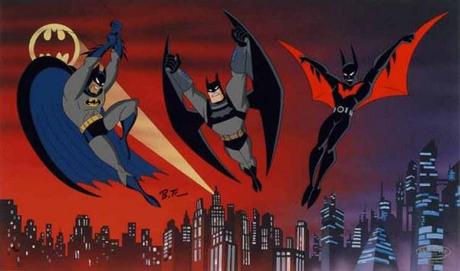
Introduction
Well, you just knew this was coming, right?
So yes, thanks to our ever more crowded summer movie season, it’s already time again for another survey of a famous character in popular culture…and they rarely come more popular than the one and only Batman. Whether you think of him as the gritty, vengeful, and brooding Dark Knight, or the noble, altruistic, and exciting Caped Crusader, the Guardian of Gotham City is an indelibly ingrained part of our popular culture, an American icon (though not always in a positive way), and the definitive urban avenger. I also don’t think it’s unfair to say that Batman has long surpassed his contemporary Superman as the world’s most famous superhero, and he’s arguably the most consistently compelling and undeniably the most commercially successful superhero of all time. For me, though, and I think for any observer of popular culture, Batman should also be considered among the most fascinating.
As times go by, many famous characters are reinterpreted and recreated for each new generation, inevitably drawing upon the various tastes and subtexts of that given moment in time. Bob Kane’s Batman, though, perhaps more than any other character I have ever seen anywhere in media, has demonstrated an astonishing ability to be readily transformed and transfigured to any given era without ever subsequently becoming an anachronism. It’s not that Batman is timeless – though he is – it’s that he’s somehow always timely. It’s an amazing attribute, and one that makes the Dark Knight not only distinctive in the history of comics, but in world literature and media as well.
For that reason, among others, there can never be a truly definitive Batman; some versions are always going to be better than others, for sure, but no character as fluid and oft-interpreted as the Dark Knight will ever manage to perfectly encapsulate his rich but dense 73 year history as a fixture in the American consciousness. But really, that’s a big part of his fun, and why I find him to be so endlessly fascinating, no matter how many times he’s recreated.
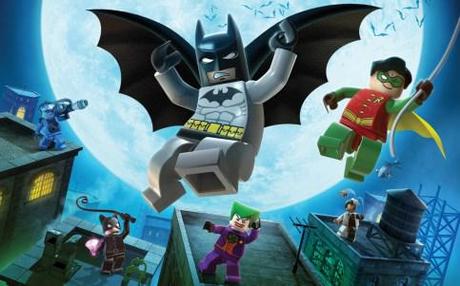
Even when it’s in LEGO form.
Now before we get started… given that Batman has been finding his way onto film screens for almost 70 years now, this entire overview is going to be done in two parts. In this first one, I’ll be looking back at the animated adaptations of Batman through the years. Next time, I’ll go over the live-action versions, including the Tim Burton, Joel Schumacher, and Christopher Nolan films and the Adam West series. In the introduction I’ll also talk about what Batman means to me, and why I think his appeal is so universal. So with that out of the way, the Bat signal’s shining, the Batmobile’s idling, and the night’s calling…so away we go…
The Adventures of Batman (Batman with Robin The Boy Wonder) (1968-1970)
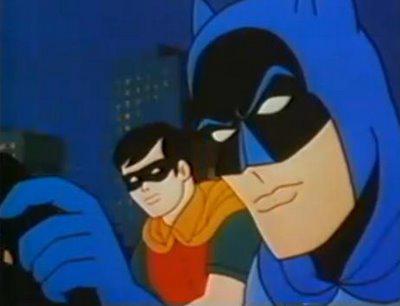
Though while notably the first of many animated interpretations of the Dynamic Duo, this Filmation series is something of a forgotten quantity, even among many long-time Batman fans. First airing as half of The Batman/Superman Hour, and then in its second year on its own as Batman with Robin The Boy Wonder, this series was produced to capitalize on the tail end of the popularity of the Adam West/Burt Ward series, to which it bears more than a few similarities, including a propensity for placing Batman and Robin in overly complicated death traps.
All told, there’s a very good reason why this show often gets forgotten: it’s pretty darned forgettable. While not in any way good, it’s also not so stupendously bad to achieve infamy. For the most part, the series was compiled of short, six to twelve minute stories (usually one or two segments, television-wise), and therefore never had the time to either develop interesting stories or get bogged down in lame, campy humor. The animation, being of its time, is pretty much terrible, though it’s supported by solid character designs; and while it includes most of the major villains of the period (and some specifically created for the series), they all essentially act like carbon copies of the Joker – loud, obnoxious, cackling, and boastful. Pretty much the nicest thing about the series I can say is that it’s almost quaint in how utterly archaic it is. Significantly, though, the two individuals who voiced Batman and Robin, Olan Soule and Casey Kasem, would voice the characters in many subsequent series, and basically became the voices of Batman and Robin for an entire generation and beyond.
The Super Friends (1973-1974, 1977-1983, 1984-1986)
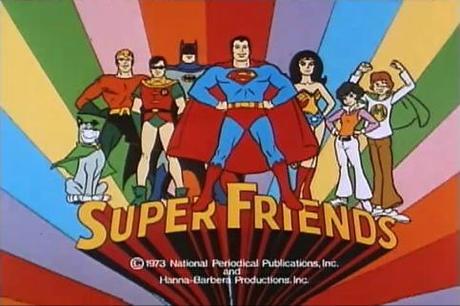
Doesn’t that just make you feel all warm and fuzzy? Yeah, me neither…
By any other name, and it was known by more than I could ever keep track of, this famous Hanna Barbera dynasty was one of the most popular kids series on television for well over a decade. If you’re somehow not familiar with the show, it was basically an overly kids-friendly version of DC Comics’ Justice League that went through many different iterations, reformats, and title changes over the course of its run, where it was a fixture on both Saturday mornings on ABC and television syndication for years and years. As the overly-fluffy title might suggest, the show was total kiddie pap (The Wonder Twins, anyone?) that for the most part can only be enjoyed nowadays in an “ironic” or “camp” way (or barring that, whilst very, very high). The semi-beloved The Challenge of the Superfriends season especially was just a mindblowing assortment of nonsensical stories and ideas that almost seemed like they were written while being animated (“I know! We’ll have Lex Luthor turn all the people in the world into Cheetahs and Bizarros!” “Why would he do that?” “Uh…um…because HE’S EVIL.”) Yet, for all of its willingness to completely insult the intelligence of its young audience, this show was, for at least two generations of American children, their introduction to the heroes and villains of the DC Universe; and those children pretty much grew up to become Generation X (which explains a lot, really…)
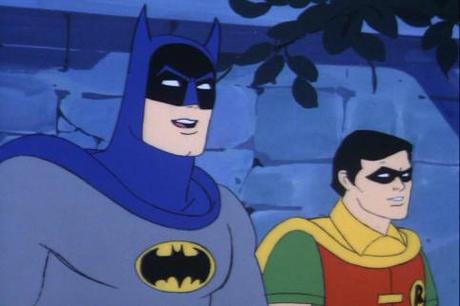
Batman and Robin, again voiced by Olan Soule and Casey Kasem for most of the series’ run, were fixtures of the show for its thirteen year existence, but they weren’t typically more developed than anyone else on the usually juvenile show.
While the Dynamic Duo were major characters on the show, the series wasn’t really big on complex characterizations, so neither Batman nor Robin (nor any of the major heroes or villains on the show) really had anything approaching a distinctive personality. Soule and Kasem again covered the voicing of Batman and Robin for most of the series’ run, with Adam West stepping in for Soule during the mid 80s, when it was eventually renamed Super Powers and the overall writing began to displaying a better level of sophistication and appreciation for its source material. The one episode that probably bears viewing for Batman fans is “The Fear” from the final season, which was designed to serve as a backdoor pilot for a new Batman series that ultimately never got off the ground. Penned by writer/producer Alan Burnett, who would go on to write for most of the animated Batman projects of the last 20 years, “The Fear” marked the first time that Batman’s tragic origin had been depicted outside of the world of the comics:
So what’s the deal with Robin avoiding girls? Hmmmm…
Batfact: Between SuperFriends airing on ABC’s Saturday morning line-up and The New Adventures of Batman airing on CBS’s, Batman was one of the only major characters in the history of Saturday morning television to appear on two of the major networks at the same time.
The New Adventures of Batman (1977-1978)
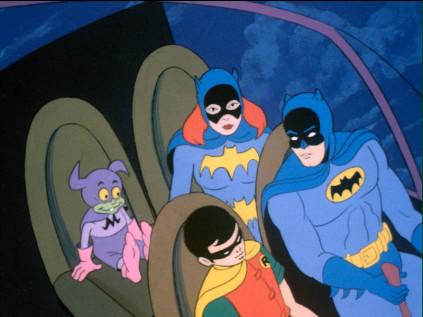
Batman, Robin, Batgirl, and…sigh…Batmite on “The New Adventures of Batman.” Really this was one of those shows that unfortunately was made, and we all have to accept it and move on…
Filmation’s second attempt to do a Batman cartoon is better known than its original, though not in a good way. Featuring Adam West and Burt Ward returning to voice the Dynamic Duo, this series was an extremely childish, intentionally goofy, and overly lighthearted attempt to recapture the charm of the 1960s television show; this time, however, Batman and Robin were joined by Batmite, a magical imp from another dimension who happened to be Batman’s biggest fan, and whose meddling always did far more harm than good. That’s right…AN IMP FROM ANOTHER DIMENSION was a major character on a Batman show. Pretty much the camp nadir of Batman in popular culture, this was obviously the complete antithesis of the dark avenger we all now view Batman to be. That, though, is not the show’s problem; I’ll of course discuss this when I review the original Adam West show, but there’s a place for the lighthearted, fun version of Batman. This show failed simply because it did a horrendous job of trying to execute that version of Batman. Say what you will about the West/Ward series, but it had a brain in its head and when it was hackneyed it was at least conscious of being hackneyed. This show was hackneyed because it simply lacked the talent and creativity to do anything better. The New Adventures of Batman, at the end of the day, was an awful concept that no one wanted to see, and thankfully, few enough people actually did. Only 16 episodes of the show were produced, and that was about 27 episodes too many (give or take). Despite its fairly limited run, reruns aired on various Filmation compilation showcases for another few years, including on, I kid you not, The Batman-Tarzan Hour.
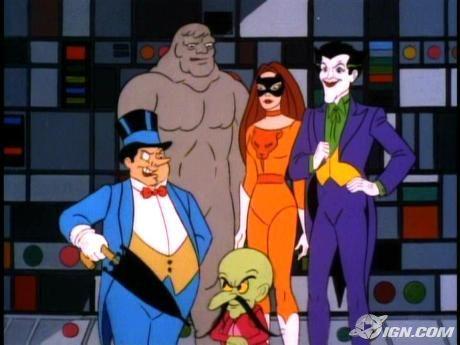
The Joker, the Penguin, Clayface, and Catwoman(what the hell?) as they appeared on the show. Oh and some alien archenemy of Batmite’s whose name I will never be bothered to commit to memory.
Batfact: While most of Batman’s major villains, including the Penguin, Joker, Catwoman, and Clayface appeared on the show, two major villains, the Riddler and Scarecrow were contracted to Hanna Barbera, where they appeared on Challenge of the SuperFriends as members of the Legion of Doom.
Batman: The Animated Series (1992-1996)
So what can really be said about Batman: The Animated Series, one of the most beloved and critically admired television shows of all time? Simply put, Batman: TAS is not only the greatest superhero T.V. show of all time, it’s also the greatest dramatic animated series ever. Drawing on the original Max Fleischer Superman cartoons for their stylistic influence, Batman: TAS eschewed the cartoonish impulses of just about every other animated show on television at the time, presenting an extremely dark, nourish Gotham City set in a kind of hybrid reality caught between post-war art deco and retro futurism. The animation style was deeply expressive and impressionistic without being unrealistic, and producer Bruce Timm’s character designs, though not particularly realistic themselves, encapsulated the personalities and personas of their timeless characters; thus what the drawings lacked for in realism, they more than made up for in truth.
The musical scores were also completely unlike most other cartoon series of their era; composed under the supervision of the late, great Shirley Walker and performed by the full Warner Brothers Orchestra (just like the Looney Tunes shorts of old), a new, specific musical score was produced for each episode, instead of the producers relying on the use and reuse of stock music cues, as Disney and others did at the time. Walker and company’s amazing, eclectic, evocative compositions, improved upon Danny Elfman’s work on the Tim Burton movies, giving Batman: TAS a sweeping grandeur that made even the lesser episodes feel incredibly cinematic.
The vocal casting, too, was without peer: in something of a marked departure from other animated television shows of the period, the series would often tap well-known actors and personalities in key roles in addition to traditional voice actors. While most shows didn’t generally call attention to their voice actors, Batman: TAS adroitly used them to add to its “prestige factor.” Just a sampling of the show’s amazing vocal cast included Ron Perlman as Clayface, David Warner as R’as Al-Ghul, Roddy McDowall as the Mad Hatter, Richard Moll as Two-Face/Harvey Dent, Adrienne Barbeau as Catwoman, John Vernon as Boss Thorne, Paul Williams as the Penguin, John Glover as the Riddler, Efreem Zimbalist, Jr. as Alfred the Butler, Robert Costanzo as Harvey Bullock, and Arleen Sorkin as Harley Quinn (who was an original creation of the series).
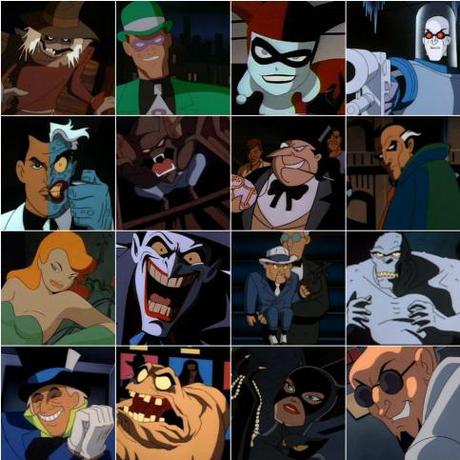
Especially in regards to its villains, the voice cast of “Batman: TAS” was one of the greatest ever assembled, including Mark Hamill, David Warner, Roddy McDowell, Richard Moll, and John Glover. (Image courtesy of ComicVine).
The two actors best remembered from the show, however, are Mark Hamill and Kevin Conroy, who voiced the Joker and Batman, respectively. Hamill, who’s of course best known for being Luke Skywalker, completely reinvented his persona through his version of the Joker, and went on to became one of the leading voice actors of the last twenty years. While his performance was drawn from many earlier cartoon villains in animation history, Hamill imbued the Clown Prince of Crime with an underlying vein of psychopathic menace, and his iconic take on the Joker’s signature laugh become synonymous with the character for most of the last twenty years.
Conroy, at the time a longtime stage and television actor doing his first cartoon series, made the part forever his own by completely capturing the darker turn the character had taken during the 1980s and 90s, while staying true to the noble core of Batman’s earlier incarnations. Conroy’s biggest innovation for the character was employing two entirely different voices for Bruce Wayne and Batman (as opposed to simply using two different timbres of the same voice, as Michael Keaton had done); the juxtaposition really emphasized the pronounced duality and psychological complexity of the Dark Knight, and emphasized into the mindset that many Batman writers have taken in the last 20 years toward the character: that Batman isn’t the mask that Bruce Wayne wears, but Bruce Wayne is the mask Batman wears. In the last twenty years, Conroy has played Batman more times than anyone in history, and while others have voiced the Dark Knight since, Conroy’s interpretation is the gold standard against which all will probably forever be compared.
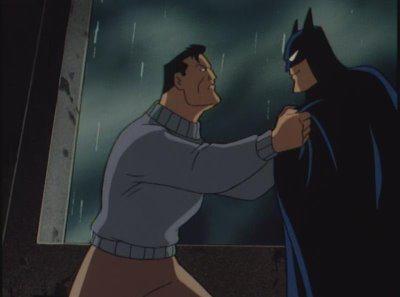
Perhaps Kevin Conroy’s most inspired contributions to “Batman: The Animated Series,” was performing Bruce Wayne and Batman as if they were almost two separate people.
While all of the elements above proved essential to the success of Batman: TAS, it was the writing, spearheaded by Paul Dini, Michael Reaves, and Alan Burnett, which brought the series to true greatness. The episodes were remarkable in the narrative complexity of their plots, the nuanced development of their characters, and the often sophisticated treatment of its material. One of the more pioneering elements of Batman: TAS that too often goes understated was that it was really the first animated series that allowed its viewers to get inside the heads of its villains, and some of the show’s best remembered episodes were those that expressly examined the human motives and traumatic origins of Batman’s deeply scarred rogues’ gallery. Perhaps the series’ most famous and possibly best episode, the Emmy-winning “Heart of Ice,” exemplified this; taking one of Batman’s campier villains, Mr. Freeze (voiced, unforgettably, by Michael Ansara), the episode, written by Dini, recast him as a compelling, sympathetic, but irreparably misguided vigilante, tragically disfigured in a cryogenics experiment gone wrong and out to avenge the death of his wife. It can be viewed online here.
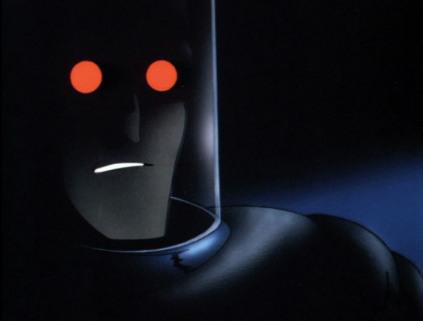
“It would move me to tears, had I tears left to shed…” Arguably TAS’s watershed episode, “Heart of Ice” was emblematic of how the series often explored the painful complexity of Batman’s deeply scarred rogues’ gallery.
In the end, Batman: TAS is one of those series, along with The Simpsons, that changed animation on television. Besides setting a heightened standard for narrative depth that is still chased to this day, the series broke numerous taboos and censorship restrictions placed on children’s television at the time. It was the first cartoon in more than a generation to depict actual gunfire on screen (even on shows like the 1980s G.I. Joe, it was mandated for handguns and rifles to shoot lasers instead of bullets), and while it rarely showed death on screen, it was never scared of implying it, nor did it shy away from depictions of blood, pain, grievous injury, or psychological trauma. Another of the more popular episodes “Harley and Ivy,” even remains noteworthy for its thinly-veiled lesbian overtones, something few, if any, series have ever dared try to do since.
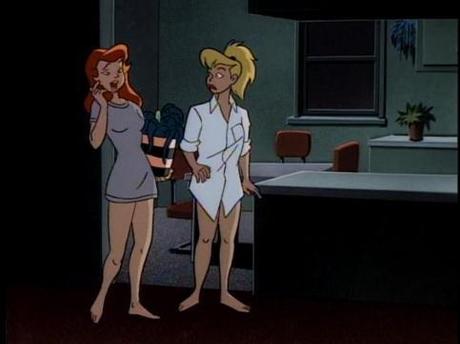
One of the kinkier episodes of the TAS, “Harley and Ivy” portrayed Harley Quinn and Poison Ivy essentially “setting up house” during their city wide crime spree.
While it seems almost commonplace to see shows referred to as “animated series” as opposed to “cartoons” nowadays, it was particularly meaningful when Batman: TAS invented the designation back in 1992. This show, then and now, was no mere children’s cartoon, but a classic television series that just happened to be animated. Batman: The Animated Series is the rare case of a legend that lives up to its hype, and while I assert that there can be such a thing as a definitive Batman, this is the one that has come closest, providing the most completely satisfying and thematically faithful presentation of the Dark Knight and his rich history that there has ever been (and probably ever will be).
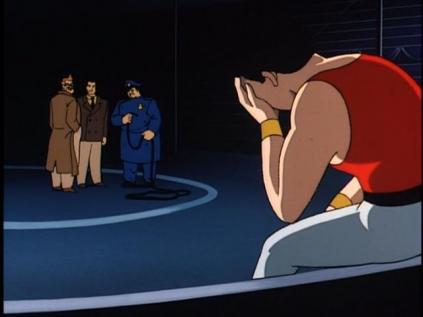
Many episodes, including the two-parter “Robin’s Reckoning,” were initially aired in prime time out of concerns over some of the subject matter; in this case, the depiction of the death of Dick Grayson’s parents.
Batfact: When the show was first being aired on the Fox Network, certain episodes were originally considered too dark and violent for airing in its after-school timeslot, and thus initially broadcast in prime time on Sunday nights. Included among these were the two-parter “Robin’s Reckoning,” which depicted the death of Dick Grayson’s parents, and “I Am the Night,” which centered on Commissioner Gordon being severely injured by machine gun fire.
For further viewing I would heartily recommend this video essay by John Keefer:
Batman: Mask of the Phantasm (2003)
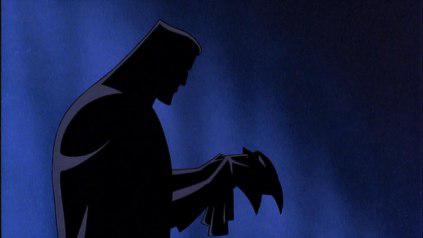
Perhaps the most intriguing element of “Mask of the Phantasm” in Batman lore was that it presented, essentially, the “Last Temptation of Bruce Wayne;” depicting him given the choice between becoming Batman, and leading a normal life.
Essentially the film version of The Animated Series, this was produced to be a direct-to-video movie that ended up being granted a theatrical release. Though criticized at the time for lacking feature quality animation, this was a very strong compliment to the series that filled in some of the animated Batman’s often undeveloped backstory. When some of Gotham City’s veteran crime bosses start showing up dead, thanks to a new, mysterious vigilante (who, in an odd oversight, is never actually referred to as “the Phantasm”), Batman is wrongfully accused of the crimes. At the same time, an old flame of Bruce Wayne shows up, leading him to recollect an earlier time in his crime-fighting career when he was tempted away from becoming Batman by the prospect of leading a normal, happy life. Overlooked in its time, the film has become regarded more fondly in recent years, and even showed up on Time’s list of the top ten superhero films of all time. I wouldn’t go that far, though; while the first part of the film, depicting, in essence, “the last temptation of Bruce Wayne,” is very compelling, the movie peters out as it goes along, and the actual mystery as to the Phantasm’s real identity leaves something to be desired. Still, it’s a good movie, and one that succeeds at being more than simply an extended episode of the actual series. Kevin Conroy again provides the voice of Batman, and he received some very strong support from Dana Delaney, Abe Vigoda, Dick Miller, Stacy Keach, and, of course, Mark Hamill as the Joker. Shirley Walker’s score was also among her best work.
Batfact: Released on Christmas 1993, Mask of the Phantasm was a huge bomb, coming in at number 10 at the box office during its opening weekend and not even making enough during its theatrical run to recoup its $6 million price tag. Because of this, it has, by a significant margin, the worst box-office record of any Batman movie.
Batman & Mr. Freeze: Sub-Zero (1997)
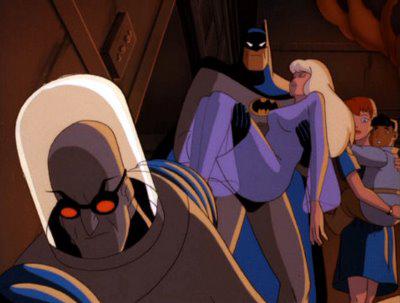
The second film to be based directly on The Animated Series, this direct-to-video feature was originally produced to be released in conjunction with the live action Batman & Robin (which also featured Mr. Freeze as the antagonist). The fierce critical backlash to that film, however, led to this one being delayed (ironically until after The New Batman Adventures, set after this show, was airing on television). While its worlds better than the calamity that Schumacher’s movie represented, this proved to be a mostly underwhelming affair. The anti-heroic Mr. Freeze (again voiced by Michael Ansara), while living in peaceful seclusion at the North Pole, is forced back to Gotham City when an arctic reconnaissance team accidentally ruptures the cryogenic chamber containing his terminally ill wife. With an organ transplant being her only chance of survival, Freeze is forced to hunt down a donor compatible with her rare blood type. Unfortunately, the only viable candidate just so happens to be Barbara Gordon, AKA Batgirl (Mary Kay Bergman), whose relationship with Dick Grayson (Lorin Lester) is beginning to get serious. Unlike Mask of the Phantasm, this one was kind of was just an extended episode of TAS, which isn’t necessarily a bad thing, but it pales significantly when inevitably compared to the classic “Heart of Ice” episode. The animation also tried to combine the series’ normal two-dimensional animation with some three dimensional CGI, to mixed results.
Batfact: Originally debuting during Batman comics’ much-maligned “science fiction” period in 1959 (when the comics were heavily censored after the 1950s Comic Book scandals) as Mr. Zero, the character of Mr. Freeze was renamed by the Adam West series; there he was portrayed – in succession by George Sanders, Otto Preminger, and Eli Wallach – as a very clichéd, ice-themed villain with a German accent. While the camp portrayals were memorable and made the character something of a household name, it was often in a derisive way, as emblematic of the West series’ high camp. The Animated Series forever changed that, leading to the character being reintroduced in the comics (after being killed off in the 1970s) and incorporating Paul Dini’s more tragic back-story; his elevated profile even led to him being given the feature film treatment (unfortunately) in Batman & Robin.
The New Batman Adventures (1997-1999)
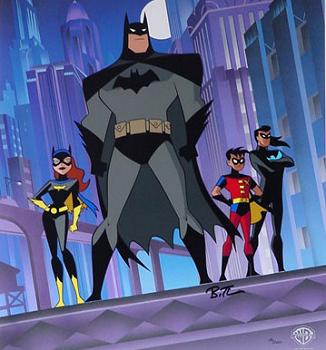
“The New Batman Adventures” continued TAS chronology by telling the continuing adventures of Batman, Batgirl, Robin, Nightwing, and Nightwing’s mullet. Ah, the 90s…
Set in the same continuity are the original Animated Series, The New Batman Adventures picked things up a few years afterward with Batman fighting crime with the help of a new, younger Robin – Tim Drake – and Batgirl, with occasional assistance from an estranged Dick Grayson, now known as Nightwing. While conceptualized by most of the same creative staff and using most of the same voice cast as TAS, New Batman wasn’t quite as good overall; its main issue was that it featured newer, far more cartoonish character designs with brighter animation that was significantly below the standards of the original series. Despite that, there were still a number of very strong episodes that were sometimes even darker in tone and subject matter than the first series; for instance taking advantage of loosened censorship standards, Bruce Timm and company made death and murder a more pronounced aspect of the show. On the flip side, though, the New Batman also featured the worst episodes of either series; in the the end, though, the good still far outweighed the bad.
Batfact: Part of the reason for the altered animation style was to keep it more in tone with the concurrent Superman: The Animated Series, which New Batman often aired in tandem with as The New Batman/Superman Adventures. As a result, Batman made a number of guest appearances on the Superman show, including a three-part, team-up episode entitled “World’s Finest,” which was released commercially to home video as The Batman/Superman Movie.
Batman Beyond (AKA Batman of the Future) (1999-2001)
This actually is the very rare example of an idea that seemed terrible in concept but actually worked in practice. When New Batman failed to gain traction with younger viewers, Warner Bros. executives asked Bruce Timm and his collaborators to devise a younger, hipper, Batman that would be more ‘kid friendly.” Timm and company balked at the idea of a teenage Batman (who wouldn’t?), but relented when the idea was presented to make him a futuristic version of the character. And thus Batman Beyond was born.
Set approximately forty years after the original Animated Series and twenty years after Bruce Wayne retired (for health reasons) as Batman, the series tells of teenager Terry McGinnis (Will Friedle), a tough Neo-Gotham kid with a juvie record whose meets up with an octogenarian Bruce Wayne (Kevin Conroy). and accidentally stumbles on the Batcave. When McGinnis’s father is murdered, he steals Wayne’s high-tech Batsuit in order to hunt down those responsible. In the process, McGinnis assumes the mantle of Batman, under Wayne’s guidance, with much of the series’ tension derived from the rebellious Terry chafing against Bruce’s militaristic devotion to crime-fighting.
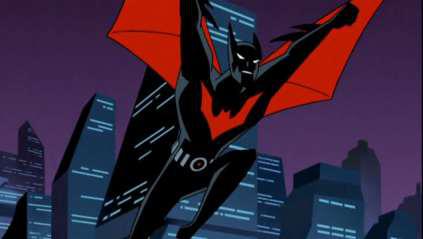
The younger, teenage Batman from Batman Beyond – while distinctive, I’ve never personally been a fan of the character’s design…though it was a minor flaw in what was a surprisingly strong show.
Though the idea of a teenager balancing high school with being Batman is more than a bit strained, the series maintained the high standards associated with what was known by this point as the DC Animated Universe, or DCAU. The series, wisely, kept references to the original Batman’s past rogues’ gallery to a minimum, giving McGinnis a mostly whole new assortment of futuristic villains and stories to challenge him. And for a supposedly “kids-friendly” show, it was still pretty darn dark, with the earlier series’ emphasis of tragedy, trauma, vengeance, and violence transposed here pretty much intact. The animation was also damned good, and the futuristic art design of the series standing as a creative achievement in and of itself.
The real key to the series’ success, though, was its sometimes fascinating portrayal of an older, crankier, world-wearier Bruce Wayne, who often reveals some of the deep personal scars and loneliness of having given his life over to being Batman. All things being equal, Conroy did his best and most nuanced voice work as the older version of Batman, who could be alternately funny and occasionally disturbing.
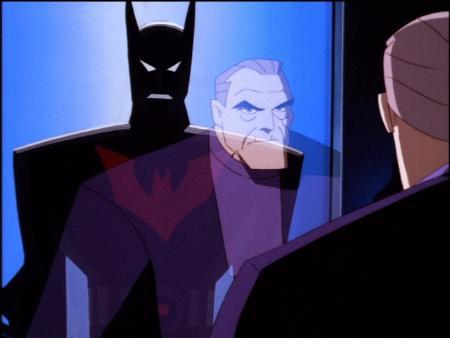
The emotional and creative anchor of the so-called “future Batman” ultimately remained Bruce Wayne, whose depiction in the series was ultimately its most compelling aspect.
The series didn’t really maintain throughout its three season run, becoming, as the older Bruce once commented in the series, “too high school.” And being honest, I never particularly liked the costume design of the futuristic Batman. Again, though, the series was far better than it was worse, and a fine demonstration that even a contrived idea could work if it has the right caliber of talent behind it.
Batfact: On the topic of being “too high school,” DC/Warners was once so obsessed with the idea of a teenage Batman it actually flirted with a horrible idea called Gotham High, which would depict Bruce Wayne at high school with teenage versions of his supervillains as classmates:
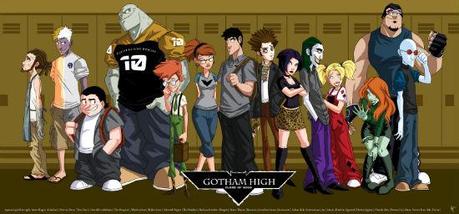
Concept art for what might have become “Gotham High.” This is, needless to say, just all kinds of wrong…
Batman Beyond: Return of the Joker
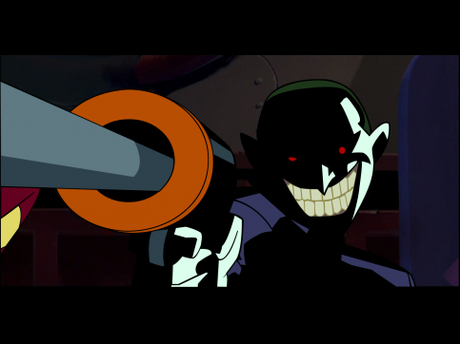
Produced as a straight-to-video movie, this, like the Batman Beyond series itself, far exceeded any and all expectations. Just as Terry McGinnis begins growing into his own as Batman and Bruce Wayne finally regains control of his family’s company, things take a hard turn for the worse when it seems that Batman’s greatest (and worst) enemy has returned from the dead to wreck havoc on Gotham once again. But is it really the one and only Joker – or is it something even more unnerving? For a straight to video movie of any kind, this was superb on many levels, with an intriguing mystery that gets right to the heart of the epic, obsessive conflict between Batman and the Joker. For longtime fans of The Animated Series, Return of the Joker also revealed what happened to Bruce Wayne/Batman, Batgirl, and Robin after the ending of The New Batman Adventures, and all told, it’s actually really disturbing. Mark Hamill also gave one of his best and nastiest performances as the Joker here.
Batfact: Prior to its initial DVD and VHS release, Return of the Joker was heavily edited for violence, including depictions of murder, and some malevolent and/or sexualized content. After an online petition from fans, Warner Bros. subsequently released the original, uncut version on DVD (which received an MPAA rating of PG-13 as opposed to the edited version’s PG). Of the two, the original version is the one to see, as the edited edition makes a major change in the flashback scenes that alters part of the backstory considerably.
Justice League/Justice League Unlimited (2001-2006)
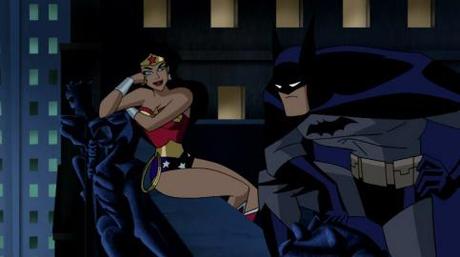
The next, and final, series set in the DC Animated Universe, this was the first major adaptation of the Justice League of America since Super Friends, and in the process incorporated both Animated Series’ Batman and Superman, and teamed them up with Wonder Woman, Green Lantern, Martian Manhunter, the Flash, and for some reason, Hawkgirl. For its first two seasons, the series focused on this smaller group of heroes, and was composed predominantly of two part standalone episodes that drew on many aspects of the DC Universe. While Batman (still voiced by Conroy) was part of a larger ensemble here (and didn’t appear in every episode), he pretty much stole every episode he was in. One of the really neat things about the DCAU was the fidelity and continuity they placed on Batman’s character from series to series; here he was sort of on in a transition between the still sometimes good-natured Batman of the original Animated Series and the hard-ass of Batman Beyond, making him someone very conscious of his own issues and who was often a few steps ahead of everybody…even his own teammates. Also, he sings:
The first season of Justice League was an infamously mixed bag, as the producers weren’t quite sure what they wanted to series to be, and it too often showed. It got much better, and more consistent, during the second season, though by that point it had driven a large part of its audience away. After the second season, the series was relaunched as Justice League Unlimited, and reformatted as mostly half-hour stories that all contributed to a much larger season-long story arc, and as a result became a far superior show. Despite a much more expanded roster of superheroes, Batman still played a major role in the new series, even though the emergence of The Batman series made many aspects of his mythology (such as his rogues’ gallery) off limits due to Warner Bros.’ fear of “brand confusion.”
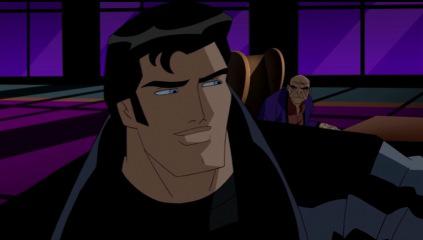
The episode “Epilogue,” originally conceived as the series finale and told from the perspective of Terry McGinnis, was designed to be final denouement for the DCAU’s Batman saga.
The final episode of the first season of JLU (which the producers thought would be the series finale), entitled “Epilogue,” was designed to be a denouement for Batman’s DCAU legacy. Written by the late Dwayne McDuffie, it was set in the distant future of Batman Beyond, with a now adult Terry McGinnis discovering that he may have more in common with Bruce Wayne than he ever thought possible. “Epilogue” was a perfect ending to the legacy of The Animated Series, and a must see for any true Batman fan.
Batfact: Though often regarded as one of the core members of the Justice League of America (and in the comics, he was a founding member), Batman often had a tumultuous relationship both on the page and behind the scenes. In the 1980s, after the reputation of the Justice League had declined, members of Batman’s editorial staff actually tried to get the Dark Knight’s history retconned so that he was never actually a member of the group.
Batman: Mystery of the Batwoman (2003)
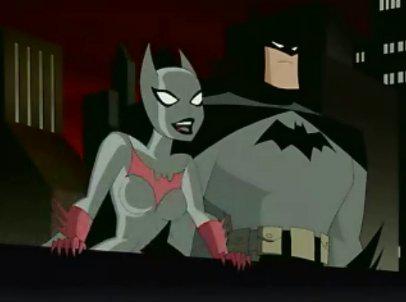
Another of DC’s straight-to-video productions, this proves notable for technically being the final incarnation of the original Batman: The Animated Series, stylistically speaking (though it used the character designs from The New Batman Adventures). Unfortunately, it’s not much as an actual movie. As the title suggests, a mysterious (and reckless) Batwoman shows up in Gotham City and begins targeting a criminal empire headed by the Penguin, leaving Batman to discover who she is before she falls victim to the Felonious Fowl and his cadre of allies…which includes Bane. Awkwardly, Bruce Wayne finds himself falling for his lead suspect. Neither particularly bad nor particularly good, but just kind of tired, Mystery of the Batwoman ultimately kind of demonstrated that all good things should come to an end, and that The Animated Series universe had overstayed its welcome. As par the course, though, it did boast a strong voice cast, including Kelly Ripa, Hector Elizondo (as Bane), and Kyra Sedgwick as Batwoman.
Batfact: The vocal cast also included Kevin Michael Richardson, who would go on to voice the Joker on The Batman, and Kimberly Brooks, who played Bruce’s love interest and a Batwoman suspect, would actually go to play the former Batgirl, Barbara Gordon, in the video game Batman: Arkham Asylum.
The Batman (2004-2009)
With Christopher Nolan’s relaunched Batman film on the horizon, this new show was produced to essentially be The Animated Series for a new generation, with a younger, hipper, more loquacious Batman and more modernized, stylized interpretations of most of his villains. Heavily inspired by anime (which was all the rage at the time) and helmed by Animated Series veteran Glen Murakami, The Batman ultimately proved to be incredibly successful, lasting five seasons on the WB network and winning multiple Emmys. With that said, it was very much despised by many critics and Batman traditionalists for going far too afield from its character and his mythology. To me, that wasn’t really the show’s biggest problem (though it was a pretty big problem); it’s that it tried way too heard to be hip and trendy, with too great an emphasis on slang and high-tech gadgetry when it absolutely wasn’t necessary.
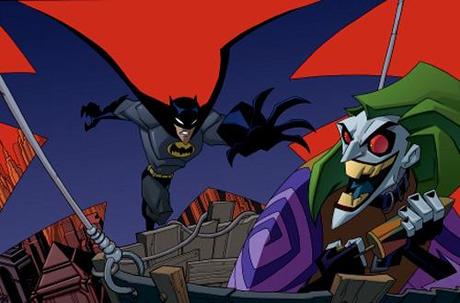
Among its many issues, “The Batman” suffered from some overly cartoonish character designs.
Make no mistake, beyond that, this still really wasn’t a good show. The storytelling was pretty threadbare at times, with narrative sacrificed readily for action sequences that felt pretty forced. The animation drew too much on anime aesthetics, and made worse by character designs that were passable at best and terrible at worst. The designs were also extremely toyetic, with Batman especially seemingly having a special suit, vehicle, or gadget for every occasion; which, narratively, also usually meant that instead of solving crimes or outsmarting his opponents, Batman usually just out-teched them. Worst of all, the show reverted most of Batman’s iconic villains from the three dimensional characters of The Animated Series and back into what amounted mostly to two-dimensional gimmicks. Of course, this show was always going to have to deal with being in the shadow of TAS, and if nothing else, it tried to be something markedly different. But it’s very telling that while TAS still feels timeless, The Batman already feels really, really dated. About a year into its run a straight-to-video feature called The Batman vs. Dracula was released, which I’ve honestly never watched, despite actually being a fan of both Batman and Dracula.
Bat-Trivia: The Batman vs. Dracula wasn’t actually the first time Batman fought Dracula on screen. None other than Andy Warhol directed his own, unofficial movie, Batman Dracula, in the early 1960s. The supposedly very campy film is rare and was actually once thought lost (which means I’ve never actually seen it), and was typically only shown at Warhol’s art exhibits and parties.
Batman: Gotham Knight
I reviewed this anthology of Batman shorts (each crafted by different manga directors) as part of my DC Original Animated Movies overview last year. My disdain for it hasn’t dimmed, though I would emphasize that it really was a colossally wasted opportunity to present the many facets of Batman over the years, as opposed to simply giving different perspectives of the same Batman. It was also Conroy’s worst outing as the Dark Knight.
Batman: The Brave and the Bold (2008-2011)
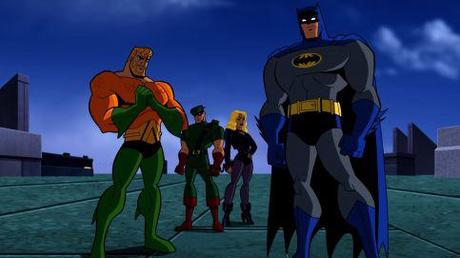
Presented as throwback to the Silver Age version of Batman (that’s “the Batman of the 1950s to late 1960s” for the non-geeks out there), Batman: The Brave and the Bold basically showed Batman as he was in the good old days: a straight arrow, good-natured good guy with a quick wit, sharp intellect, and affable personality. In other words, NOT the Dark Knight. Also, in keeping with its namesake comic, The Brave and the Bold was mainly centered on the Caped Crusader teaming up with various obscure superheroes of the DC Universe to battle their sometimes equally obscure villains. While certainly not a portrayal of the brooding, bad ass Batman most people of the last twenty five years identify with, this show does a fine job of celebrating the character’s often overlooked and repressed legacy as a once lighthearted kids character. The best part, though, is that it’s also very self aware of that fact, and the show often has a lot of fun breaking the fourth wall and acknowledging that it’s not always everyone’s idea of Batman. Needless to say, The Brave and the Bold isn’t for everyone, and it sometimes forsakes smart humor for childishness, but I give it credit for trying to be drastically different from nearly every other modern incarnation of Batman, and mostly succeeding on those terms. It also boasts some pretty terrific voice casting, led by Diedrich Bader as Batman.
Batfact: If there’s one episode that every Batman fan should try to see, it’s Paul Dini’s “Chill of the Night!” which adapted the classic Silver Age story of Batman finally confronting his parents’ killers; besides being far darker in tone than the rest of the series, it also featured guest voices from Adam West and Julie Newmar as Bruce Wayne’s parents, as well as Animated Series veterans Kevin Conroy, Mark Hamill, and Richard Moll. Fittingly, it was also the only episode of the series that saw Batman working on his own, without the weekly “guest superhero.”
Superman/Batman: Public Enemies (2009) / Superman/Batman: Apocalypse (2010)
Again, I covered these two movie adaptations of the Superman/Batman comic book series in my previous DC Animation overview, and my opinions of them haven’t changed; as I say in that piece, however, these lean more towards being Superman stories than Batman stories.
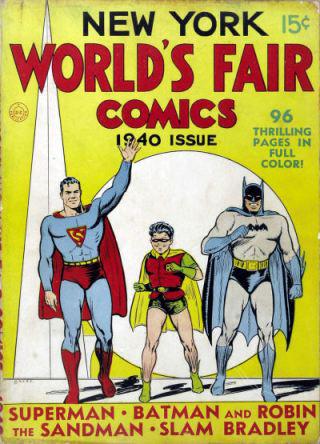
The 1940 issue of “New York World’s Fair Comics,” which marked the first time Batman and Superman had ever appeared together.
Batfact: Though portrayed often in the modern era as being as much frenemies as friends, Batman and Superman have a long history in comics together; their first joint appearance together occurred on the cover of 1940 New York World’s Fair Comics (released the year after Batman’s debut); though they didn’t appear in the same stories within the issue, the image was significant for specifying that the two characters existed in the same storytelling “universe.” In the eyes of many, this marked the very beginning of DC Comics’ overarching continuity.
Justice League: Crisis on Two Earths (2010)
Once again, I wrote about this in my earlier overview, but since I didn’t discuss Batman in I probably should embellish a bit. Though among the least successful of the DC Original movies so far, this was actually among the best they’ve made, with a terrific script by Dwayne McDuffie. The story basically sees the Justice League teaming up with an alternate universe Lex Luthor (who is his Earth’s only surviving superhero) to do battle with an evil incarnation of the Justice League called the Crime Syndicate, all of whom are slightly altered antitheses of the main character. The chief villain, Owlman (voiced superbly by James Woods) is Batman’s evil doppelganger, a completely nihilistic psychotic bent on destroying all universes. As a result, the film’s final battle belongs to Batman, and it’s a pretty darn good one that features one of the best Batman lines I’ve ever heard. All told, the entire movie is so good you won’t even mind that Batman is actually being voiced by Billy Baldwin of all people.
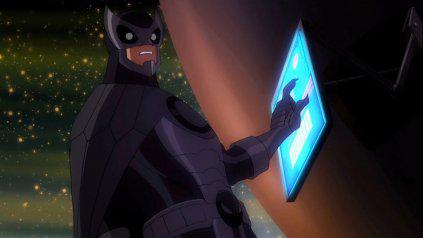
“Crisis on Two Earths” featured Batman’s nihilistic doppelganger, Owlman (James Woods) as the chief villain.
Batfacts: Though never touched on in the movie, Batman’s doppelganger Owlman (whose namesake is a bat’s natural predator) isn’t actually an alternate universe Bruce Wayne, but Thomas Wayne, Jr., the older brother (and murderer) of that universe’s Bruce Wayne. Because Owlman never actually had a counterpart in the “real” universe, it’s led to many fans speculating over the years that Batman may someday be revealed as having a long lost older brother.
Batman: Under the Red Hood (2010 – )
In the earlier overview again, though it bears repeating that this represented the best overall animated Batman since the end of the DCAU, and really a must see for anyone who is a fan of Batman in the modern era.
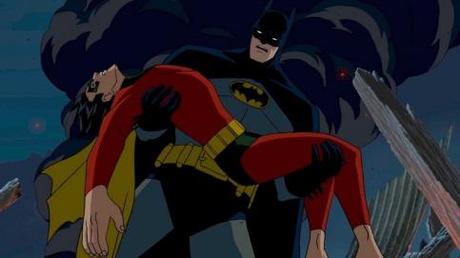
“Batman: Under the Red Hood” adapted from the comics both the tragic death and resurrection of the second Robin, Jason Todd.
Batfact: Under the Red Hood adapted the return from the dead of Jason Todd, the very dysfunctional (and unpopular) second Robin, who was killed by the Joker in the famed 1988 storyline, “A Death in the Family.” The death of Robin was huge media story at the time (even though it wasn’t the same Dick Grayson/Robin most knew) and was particularly controversial because DC Comics actually let fans vote, via a 900 number, on whether Todd/Robin would live or die. The final vote had Todd dying by a very slim margin of only 72 votes. Longtime Batman editor Denny O’Neill has claimed in interviews that he had heard that one individual, using a preprogrammed autodialer, may have voted 100 times (enough to skew the vote), but this story has never been corroborated. It was revealed, some years later, that even if the fans had voted for the Jason Todd character to live, the plan was always for him to leave the role of Robin at the end of the storyline.
Young Justice (2010 – )
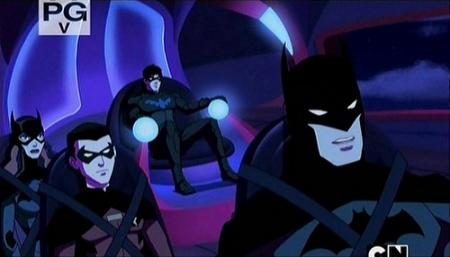
As the title suggests, this series tells of the junior version of the Justice League, which is made up of sidekicks like Robin, Kid Flash, Aqualad, Superboy, and others, and despite what one might think, it’s actually a pretty sophisticated show, well in keeping with the legacy of Justice League Unlimited and other DCAU series (though it’s set in its own, very unique continuity). Beside Robin/Dick Grayson having a significant role in the show, Batman (voiced by Bruce Greenwood, who also played the part in Under the Red Hood) plays the role of the team’s mission officer, who sends the team out on their weekly assignments. In the second season, set five years after the first, Dick Grayson has become Nightwing (assuming Batman’s earlier responsibility) and Tim Drake and Barbara Gordon have assumed the roles of Robin and Batgirl, respectively. While Batman isn’t featured in every episode, Dick Grayson’s angst over turning out too much like his mentor has represented an ongoing character arc in the series. Some of the Dark Knight’s rogues’ gallery has also shown up throughout the series in small roles, including R’as al-Ghul, Hugo Strange, the Riddler, Bane, Mr. Freeze, Poison Ivy, and the Joker.
Batfact: Though Dick Grayson is a household name as the alter-ego of Robin, in mainstream continuity he hasn’t actually been Robin since 1983 when he first assumed the role of solo vigilante Nightwing. Beginning in 2009, after Bruce Wayne/Batman was “killed” in DC’s Final Crisis miniseries, he temporarily assumed the role of Batman, with Bruce Wayne’s long lost son Damian Wayne as his Robin.
Batman: Year One
I actually wrote a full length review and analysis of the movie here, which I was personally pretty proud of; short version, though, is that this was an underwhelming adaptation of Frank Miller’s legendary graphic novel, that seemed to complete fail to grasp what made said graphic novel such a classic.
Batfact: Our modern perception of Batman as a tortured, somewhat antisocial, and fearsome avenger whose perspective on the world is sometimes unremittingly dark (crystallized most notably in the Christopher Nolan movies) has its true genesis in Miller’s Year One and The Dark Knight Returns, both published in the 1980s, both of which forever changed how many people not only read, but subsequently presented, Batman.
Justice League: Doom (2012)
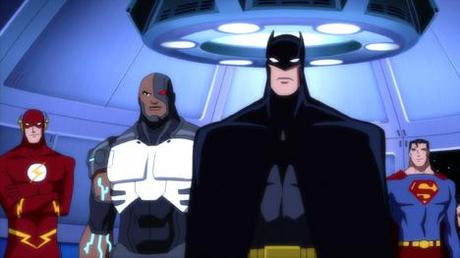
Representing the last script Dwayne McDuffie completed prior to his death last year, Justice League: Doom, unfortunately, didn’t represent his best work. Based on the central concept of the classic JLA storyline, “Tower of Babel,” it tells of the immortal supervillain Vandal Savage and his latest incarnation of the Legion of Doom getting their hands on Batman’s secret contingency plans for the other Justice Leaguers: fail-safes, essentially, just in case any of the League’s super-powered members – Superman, Wonder Woman, Green Lantern, the Flash, and Martian Manhunter – every became a threat to humanity. When the Legion sets these plans into action, it’s up to Batman and the young superhero Cyborg to try and save the day. While the central idea behind the story has always been fantastically ripe for adaptation (and often speculated as the basis for a proposed Justice League feature film), Doom sadly kind of botches it. Batman plays a major part in the story here, but the central question at the heart of the original storyline, “Was Batman right to potentially plot against his friends and allies, even in the name of the greater good?” is ultimately not explored to any satisfying degree in the movie, in favor of shoehorning the Legion and Cyborg into the story in the name of excess action scenes. While the producers, and especially Bruce Timm, clearly wanted to make the script, as is, in tribute to McDuffie, the sad fact is that it was clearly in need of a rewrite, as many of Batman’s actual plans don’t even make sense in retrospect. One of the film’s marketing hooks was that it reunited many of the classic voice actors of the DCAU as their original characters, including Kevin Conroy as Batman, yet it ultimately didn’t give them anything terribly interesting to do.
Batfact: Tragically, Dwayne McDuffie passed away on February 21, 2011, just one day after his 49th birthday. A certified genius, McDuffie was a critically acclaimed and extremely prolific writer and story editor in animation and comic books, including the popular Ben 10 animated series, and both the Justice League animated series and JLA comics, among many, many others. Though he was incredibly adept at giving voice to many of the most iconic comic book characters of all time, including Batman, his greatest legacy was probably as co-founder and editor of the well-remembered Milestone Comics. Milestone’s mission was to present a wider range of minority characters in the world of superhero comic books, told often from the perspective of minority authors and artists. McDuffie, who was black, created and co-created a number of major characters for Milestone, many of which are now part of the mainstream DC Unvierse. One of them, the teenage superhero Static, was the subject of his own acclaimed television series, Static Shock, that ran from 2000-2004; in the first episode of its second season, called “The Big Leagues,” the character received an endorsement from a pretty major guest star: Batman.
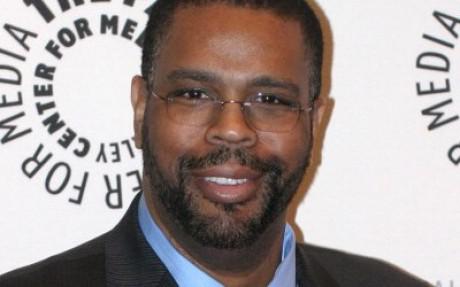
Dwayne McDuffie (1962 – 2011)
Conclusion:
And so ends this look back at the long legacy of Batman in animated media, which even as I write this is due to expand with the release of the animated adaptation of The Dark Knight Returns being released later this year, and a new series done in 3D computer animation, Beware the Batman, airing next year. But for right now, look out for the live-action half of the Best and Worst of Batman next week: same Bat-time, same Bat…um…blog…

